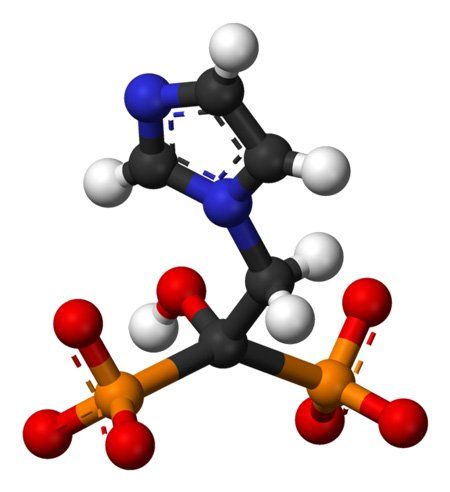Bisphosphonate Usage Low in Prostate Cancer Patients on ADT
Despite recommendations calling for their use, prescriptions for bisphosphonates among older men with prostate cancer undergoing ADT are still low.
Ball-and-stick model of the bisphosphonate zoledronic acid.

Despite recommendations calling for their use, prescriptions for bisphosphonates among older men with prostate cancer undergoing androgen deprivation therapy (ADT) are still low, results of a research letter published in JAMA indicated.
“As the most widely used class of prescription drugs for osteoporosis, this suggests limited awareness among clinicians regarding optimal bone health management,” wrote Husayn Gulamhusein, BHSc, of University Health Network, Toronto, Ontario, and colleagues.
According to background information, Canadian guidelines have called for the use of bisphosphonates among men undergoing ADT since 2006.
In the study, the researchers looked at the rate of bisphosphonate prescribing patterns in men aged 66 years or older initiating ADT in Ontario between 1995 and 2012. To do that they used information from the Institute for Clinical Evaluation Sciences and the Ontario Cancer Registry, which captures any bisphosphonate claim within 12 months of ADT initiation.
Results indicated that although 35,487 men with prostate cancer initiated ADT during the study period, prescriptions for bisphosphonates remained low. From 1995-1997 bisphosphonates claims were 0.35 per 100 persons but increased to 3.40 per 100 persons in 2010-2012.
The highest bisphosphonate claim period was between 2007-2009 with a rate of 11.89 per 100 persons in those with prior osteoporosis. The researchers posited that the decrease since 2009 may be due to negative media reports discussing a link between the drugs and osteonecrosis of the jaw and atypical femoral fractures.
“Although the optimal rate of bisphosphonate use in men on ADT is unknown, it is reasonable that most men with prior osteoporosis or fracture should be taking a bisphosphonate or other effective bone medication,” the researchers wrote.